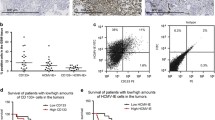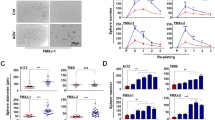Abstract
Objective
To establish a stable C6/EGFP glioma cell line for studies on glioma.
Methods
The C6 glioma cell line was transfected with the human immunodeficiency virus type I (HIV-1) based lentivirus vector containing two enhancer-promoters CMV and EF1α. Enhanced green fluorescent protein (EGFP)-positive C6 cells were sorted out by fluorescence-activated cell sort. Expression of EGFP was observed by fluorescent microscopy. EGFP gene in C6 genome was assessed by Polymerase chain reaction (PCR) and DNA sequencing. Original and transfected cells were compared biologically and cytomorphologically.
Results
Lentivirus vector transfection produced up to 40% EGFP-positive cells. After fluorescence-activated cell sort selection, a pure cell line C6/EGFP was established. PCR and DNA sequencing revealed integration of EGFP gene in C6 cell genome. Analysis of cell characteristics revealed no difference between transfected and original cells.
Conclusion
A C6/EGFP cell line expressing EGFP as a marker is established, in which the EGFP gene is integrated into the genome. This cell line can be served as a promising tool for further basic research and gene therapy studies.
Similar content being viewed by others
References
Legler JM, Ries LA, Smith MA, et al. Cancer surveillance series [corrected]: brain and other central nervous system cancers: recent trends in incidence and mortality[J]. J Natl Cancer Inst 1999; 91: 1382–1390.
Surawicz TS, Davis F, Freels S, et al. Brain tumor survival: results from the National Cancer Data Base[J]. J Neurooncol 1998; 40: 151–160.
Cheng L, Fu J, Tsukamoto A, et al. Use of green fluorescent protein variants to monitor gene transfer and expression in mammalian cells[J]. Nat Biotechnol 1996; 14: 606–609.
Bouvet M, Wang J, Nardin SR, et al. Real-time optical imaging of primary tumor growth and multiple metastatic events in a pancreatic cancer orthotopic model[J]. Cancer Res 2002; 62: 1534–1540.
Zhang G, Gurtu V, Kain SR. An enhanced green fluorescent protein allows sensitive detection of gene transfer in mammalian cells[J]. Biochem Biophy Res Commun 1996; 227: 707–711.
Hoffman RM. Green fluorescent protein imaging of tumor growth, metastasis, and angiogenesis in mouse models[J]. Lancet Oncol 2002; 3: 546–556.
Amoh Y, Nagakura C, Maitra A, et al. Dual-color imaging of nascent angiogenesis and its inhibition in liver metastases of pancreatic cancer[J]. Anticancer Res 2006; 26: 3237–3242.
Hoffman RM. In vivo cell biology of cancer cells visualized with fluorescent proteins[J]. Curr Top Dev Biol 2005; 70: 121–144.
Condeelis J, Segall JE. Intravital imaging of cell movement in tumours[J]. Nat Rev Cancer 2003; 3: 921–930.
Yang M, Baranov E, Jiang P, et al. Whole-body optical imaging of green fluorescent protein-expressing tumors and metastases[J]. Proc Natl Acad Sci USA 2000; 97: 1206–1211.
Yang M, Baranov E, Wang J-W, et al. Direct external imaging of nascent cancer, tumor progression, angiogenesis, and metastasis on internal organs in the fluorescent orthotopic model[J]. Proc Natl Acad Sci USA 2002; 99: 3824–3829.
Flannery JG, Zolotukhin S, Vaquero MI, et al. Efficient photoreceptor-targeted gene expression in vivo by recombinant adeno-associated virus[J]. Proc Natl Acad Sci USA 1997; 94: 6916–6921.
Bennett J, Duan D, Engelhardt JF, et al. Real-time, noninvasive in vivo assessment of adeno-associated virus-mediated retinal transduction[J]. Invest Ophthalmol Vis Sci 1997; 38: 2857–2863.
Bennett J, Maguire AM, Cideciyan AV, et al. Stable transgene expression in rod photoreceptors after recombinant adeno-associated virus-mediated gene transfer to monkey retina[J]. Proc Natl Acad Sci USA 1999; 96: 9920–9925.
Miyoshi H, Takahashi M, Gage FH, et al. Stable and efficient gene transfer into the retina using an HIV-based lentiviral vector[J]. Proc Natl Acad Sci USA 1997; 94: 10319–10323.
Jakobsson J, Ericson C, Jansson M, et al. Targeted transgene expression in rat brain using lentiviral vectors[J]. J Neurosci Res 2003; 73: 876–885.
Trobridge G, Russell DW. Cell cycle requirements for transduction by foamy virus vectors compared to those of oncovirus and lentivirus vectors[J]. J Virol 2004; 78: 2327–2335.
Blesch A. Lentiviral and MLV based retroviral vectors for ex vivo and in vivo gene transfer[J]. Methods 2004; 33: 164–172.
Carlotti F, Bazuine M, Kekarainen T, et al. Lentiviral vectors efficiently transduce quiescent mature 3T3-L1 adipocytes[J]. Mol Ther 2004; 9: 209–217.
Vogel R, Amar L, Thi AD, et al. A single lentivirus vector mediates doxycycline-regulated expression of transgenes in the brain[J]. Hum Gene Ther 2004; 15: 157–165.
Blomer U, Naldini L, Kafri T, et al. Highly efficient and sustained gene transfer in adult neurons with a lentivirus vector[J]. J Virol 1997; 71: 6641–6649.
Naldini L, Blomer U, Gallay P, et al. In vivo gene delivery and stable transduction of nondividing cells by a lentiviral vector[J]. Science 1996; 272: 263–267.
Naldini L, Blomer U, Gage FH, et al. Efficient transfer, integration, and sustained long-term expression of the transgene in adult rat brains injected with a lentiviral vector[J]. Proc Natl Acad Sci USA 1996; 93: 11382–11388.
Miyoshi H. Gene delivery to hematopoietic stem cells using lentiviral vectors[J]. Methods Mol Biol. 2004; 246: 429–438.
Kim EY, Hong YB, Lai Z, et al. Long-term expression of the human glucocerebrosidase gene in vivo after transplantation of bone-marrow-derived cells transformed with a lentivirus vector[J]. J Gene Med 2005; 7: 878–887.
Yip PK, Wong LF, Pattinson D, et al. Lentiviral vector expressing retinoic acid receptor beta2 promotes recovery of function after corticospinal tract injury in the adult rat spinal cord[J]. Hum Mol Genet 2006; 15: 3107–3118.
Shichinohe T, Bochner BH, Mizutani K, et al. Development lentiviral vectors for antiangiogenic gene delivery[J]. Cancer Gene Ther 2001; 8: 879–889.
De Palma M, Venneri MA, Naldini L. In vivo targeting of tumor endothelial cells by systemic delivery of lentiviral vectors[J]. Hum Gene Ther 2003; 14: 1193–1206.
Author information
Authors and Affiliations
Corresponding author
Additional information
This work was supported by the National Natural Science Foundation of China (No. 30640073); Beijing Municipal Natural Science Foundation; and the Scientific Research Foundation for Returned Scholars, from Ministry of Education of china.
Rights and permissions
About this article
Cite this article
Jin, Gs., Liu, Fs., Chai, Q. et al. Stable EGFP gene expression in C6 glioma cell line after transduction with HIV-1-based lentiviral vector. Chin. J. Cancer Res. 20, 243–248 (2008). https://doi.org/10.1007/s11670-008-0243-5
Received:
Accepted:
Published:
Issue Date:
DOI: https://doi.org/10.1007/s11670-008-0243-5




